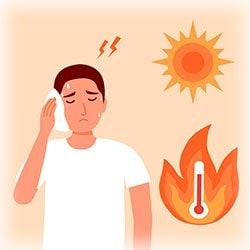Beat the Heat: Understanding Heat-Related Illnesses
 As summer rolls in, so does the sweltering heat, increasing the risk of concerning heat-related illnesses. “Heat-related illnesses are not uncommon and can become life-threatening if left unchecked,” shares PIH Health Physician Mark Magged. Prepare for the summer by learning about the effects of heat cramps, heat exhaustion and heat stroke.
As summer rolls in, so does the sweltering heat, increasing the risk of concerning heat-related illnesses. “Heat-related illnesses are not uncommon and can become life-threatening if left unchecked,” shares PIH Health Physician Mark Magged. Prepare for the summer by learning about the effects of heat cramps, heat exhaustion and heat stroke.
Heat Cramps: The First Warning Sign
When your body loses fluids and essential electrolytes through sweating, heat cramps may occur. These painful muscle contractions can serve as an early indicator that your body is struggling to cope with the heat. Here's what you need to know:
Symptoms: Intense muscle spasms, particularly in the legs, arms, or abdomen.
Treatment: Rest in a cool place, drink fluids containing electrolytes (avoid caffeinated or alcoholic beverages), and gently stretch and massage the affected muscles. Seek medical attention if cramps persist for more than an hour.
Prevention: Stay hydrated, especially during physical activity, by drinking plenty of water and consuming electrolyte-rich foods like bananas, oranges and sports drinks.
Heat Exhaustion: When Your Body Overheats
Heat exhaustion is a more severe condition resulting from prolonged exposure to high temperatures and inadequate fluid intake. “Heat exhaustion can be a precursor to heat stroke if not addressed promptly,” explains Dr. Magged.
Symptoms: Profuse sweating, weakness, dizziness, nausea, headache, pale or clammy skin, elevated heart rate and rapid breathing.
Treatment: Move to a cool, shaded area, remove excess clothing, slowly drink cool fluids, apply cool compresses to the body. Seek medical assistance if symptoms worsen or persist.
Prevention: Wear lightweight, breathable clothing, take frequent breaks in shaded areas and drink plenty of fluids before, during and after outdoor activities. Avoid strenuous exercise during the hottest parts of the day.
Heat Stroke: A Life-Threatening Emergency
Heat stroke is the most severe form of heat illness and requires immediate medical attention. It can lead to organ damage and even be fatal if not treated promptly. Recognizing the signs and taking immediate action can save lives:
Symptoms: High body temperature (above 103 degrees Fahrenheit), absence of sweating, confusion, irritability, seizures, rapid pulse, throbbing headache, flushed or red skin, and unconsciousness.
Treatment: Call emergency services immediately. Move the person to a cool place, remove excess clothing, cool the body with wet towels or by spraying with cool water, and fan the person to promote evaporation.
Prevention: Stay well-hydrated, avoid prolonged exposure to hot environments and be vigilant for symptoms of heat exhaustion. Ensure vulnerable individuals, such as the elderly and young children, have access to cool environments and regular hydration.
Copyright 2023 © Baldwin Publishing, Inc. All rights reserved. Health eCooking® is a registered trademark of Baldwin Publishing, Inc. Cook eKitchen™ is a designated trademark of Baldwin Publishing, Inc. Any duplication or distribution of the information contained herein without the express approval of Baldwin Publishing, Inc. is strictly prohibited.